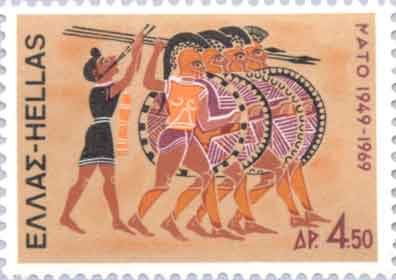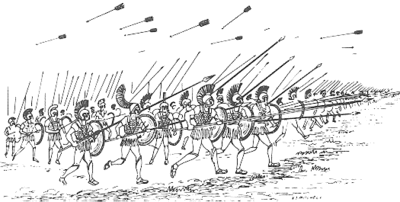.

Hoplits, Chigi Vase ca. 625 BC.
The Phalanx (pl. Phalanges) (Gr. Finger, anatomically the bones of the toes and fingers) (soldiers in close order), refers to the soldiers’ spears thrusting out from the main body like fingers from a palm.
A phalanx (plural phalanxes or phalanges) is a rectangular mass formation, usually composed entirely of heavy infantry armed with spears, pikes, or similar weapons. The phalanx is a hallmark of Hellenistic or ancient Greek warfare. The first phalanges appear on Sumerian inscriptions, and they dominate the battlefield for millennia, reaching their culmination in the Macedonian phalanx under Alexander the Great and his successors.

Some historians and authorities date the formation of the hoplite phalanx of ancient Greece to the eighth century BC in Sparta, though this is being revised as it is more likely that the formation was devised in the seventh century BC after the introduction of the Hoplon shield by the city of Argos, after the introduction of which the formation would have been made possible.
The hoplite phalanx was a formation in which the hoplites would line up in files, no less than four deep, in very close order. In this formation, the hoplites would lock their shields together, while the first few ranks of soldiers would project their spears out over the first rank of shields, thus allowing for the first three or so ranks of spearmen to engage their spears against the enemy. Therefore, one might say that the phalanx was essentially a formation in which the hoplites created a mass spear and shield wall. The effectiveness of the phalanx depended upon how well the hoplites could maintain this formation while in combat, especially when engaged against another phalanx.
When in combat, the whole formation would consistently press forward trying to break the enemy formation, thus when two phalanx formations engaged, the struggle essentially became a pushing match, in which, as a rule, the deeper phalanx would almost always win, with very few recorded exceptions. The natural tendency during battle would be to drift towards the right side. This is because the individual hoplites carried their shields on their left arm. Battles were won when the exposed right side (carrying spears) could overpower the opposing army's left side (carrying shields).
While this formation was formidable, and nearly indestructible from the front, the formation was very slow when maneuvering, and could not, of itself, protect its flanks, nor its rear, because it was a terribly slow moving formation and when once engaged, could not disengage, or remaneuver itself. Therefore, when the Phalanx was flanked (attacked from either the left or right side) it was rendered nearly defenseless. We see this at the battle of Pydna in which the Macedonian phalanx, when engaged against the Roman infantry, was destroyed once it was outflanked by cavalry, simply because it could not defend itself from or fend off such an attack.
Another weakness the phalanx faced was light missile troops such as archers or slingers. These troops could stay a safe distance from the phalanx while at the same time subjecting it to missile fire, thus forcing it to either surrender, or retreat. We see this at the battle of Lechaeum, where an Athenian army lead by Iphicrates, consisting of light missile troops armed with peltasts and bows, succeded in routing an entire Spartan mora (a Spartan army numbering anywhere from five to nine hundred hoplites).
It is due to the two above enumerated weakness that the phalanx was made obsolete by the more flexible Roman legion, and seems to have disappeared after the battle of Pydna in the year 168 BC, after which Macedonia and Hellas were made Roman provinces.
In the middle ages, the phalanx enjoyed a brief revival in the form of the swiss phalanx (see Landsknecht), a much narrower formation than the hoplite phalanx, usually no more than 20 or 30 men wide, but considerably deeper. The Swiss phalanx had great success - particularly against French cavalry - for almost a half century, but came to an end with the Swiss defeat in the battle of Marignano.
See also
Sarissa, a kind of pike used by Macedonian phalangites
| Ancient Greece
Science, Technology , Medicine , Warfare, , Biographies , Life , Cities/Places/Maps , Arts , Literature , Philosophy ,Olympics, Mythology , History , Images Medieval Greece / Byzantine Empire Science, Technology, Arts, , Warfare , Literature, Biographies, Icons, History Modern Greece Cities, Islands, Regions, Fauna/Flora ,Biographies , History , Warfare, Science/Technology, Literature, Music , Arts , Film/Actors , Sport , Fashion --- |
Retrieved from "http://en.wikipedia.org/"
All text is available under the terms of the GNU Free Documentation License

